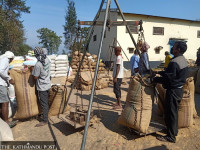Money
Nepali footwear losing charm, export drops 27 percent
Local manufacturers have been focusing on expanding their domestic market share while putting low focus on export
Krishana Prasain
The export of footwear has dwindled by 27 percent in the last fiscal year due to price competitiveness in the international market, lack of technology and skilled manpower, manufacturers say.
According to annual trade statistics of Trade and Export Promotion Centre, the country exported footwear of Rs905 in the last fiscal year 2018-19, against Rs1.23 billion in the previous fiscal year.
Lack of modern technology in the footwear has been the key reason behind the drop in production, said Krishna Kumar Phuyal, president of Footwear Manufacturers Association of Nepal. “Domestic footwear is not able to compete with international brands as Nepali manufacturers are dependent on the traditional manufacturing process,” he said.
Uttam Adhikari, senior vice-president of the association, said that high-interest rate on loan has discouraged the industry from expanding. “The rising cost of production is another factor which has made the industry struggle,” he said, adding that the rise in the workers' wages have increased the production costs as well.
According to Phuyal, local manufacturers have been focusing on expanding their domestic market share while putting low focus on export. “We are focusing to fulfilling internal demand for now,” he said, adding that export is not our priority currently.
In addition to this, he said the domestic demand has also been increasing in recent years. “The demand for domestic footwear which was 35-40 percent a few years ago has increased to 55-60 percent now.”
Goldstar, one of the popular Nepali footwear brands, is one of the major brands exporting to India.
The statistics show that imports of footwear has nearly doubled to Rs7.49 billion in the last fiscal year. In the previous fiscal year, footwear imports were Rs4 billion.
Manufacturers said that import has risen as the growing middle class of Nepal prefer foreign goods to domestic goods and also due to updated shoe fashion. They said that domestic footwear are not able to compete with low-priced products from India and China in the international market.
Footwear is mainly imported from China and India among other countries while India is major footwear market for Nepal.
Nepal has been importing sports and leather shoes majorly from China. The demand for footwear stands at 80 million pairs annually in the country, said the association. Of the total demand, domestic companies produce 40 million pairs of footwear.
As Chinese shoes are relatively cheaper than the domestic products and come with the latest designs, people prefer to buy imported footwear. Similarly, the cost of domestic production has also increased massively this year with a rise in labour costs.
The country has been importing 70-75 percent of raw materials from India, said Phuyal.
Similarly, the government had included footwear in the Nepal Trade Integration Strategy list in 2016. According to officials at the Ministry of Industry, Commerce and Supplies said that the government had included the items in the list following pressure from traders hoping to benefit from the incentive scheme.
Adhikari, said that lack of skilled manpower is a major problem in the industry. Adhikari, who is also managing director of Chitwan Footwear, said that he has been making monthly turnover of around Rs2.5 million and producing 400 pairs of ladies sandals per day.
There are around 1,500 footwear businesses operating in the country, said the association.




 10.12°C Kathmandu
10.12°C Kathmandu













